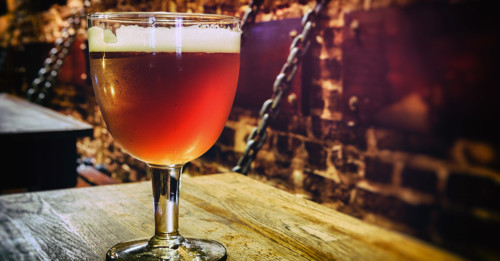If you’ve had even a glimpse into the world of Belgian beer, you can already tell: Belgians love their beer, and they’ve spent time—centuries, in fact—perfecting it. But Belgians are also pretty liberal with their beer, meaning “styles” are a bit hard to nail down. And terms like “Trappist” and “Abbey” don’t quite help (“Trappist” actually means the beer was brewed by monks at one of 11 abbeys currently brewing; “Abbey” is a marketing term used to imply an association with an abbey, though technically it doesn’t mean one exists). But don’t be afraid of confusion—the world of Belgian beer is so rewarding, in terms of flavor and complexity, it’s worth diving into the deep end.
Belgian Dubbel Essential Info
- Color: Rich amber to copper
- ABV: 6%-9%
- Commercial Examples: Ommegang Abbey Ale, Westmalle Trappist Dubbel, Chimay Premiere (Red)
The “lowest” of the number-sounding Belgian beer names, created by Belgian monks at the Westmalle Monastery in between the late 19th and early 20th century (they brewed a stronger version of what they drank at the abbey, hence “dubbel,” or “double,” and the rest is history). Complex and fairly high alcohol, the deep color of the Dubbel doesn’t come from roasted malt but something called candi sugar (originally brewers used caramelized beet sugar), which imparts chocolate, dark fruit, and/or burnt caramel qualities. Hops flavors won’t make much of a showing beyond a trace of moderate bitterness, allowing the malt and yeast to impart more of their flavors, with Belgian yeast strains lending some peppery spiciness, fruity esters, and higher alcohol to balance out the round, ruby voluptuousness.
Belgian Tripel Essential Info
- Color: Light pale to deep gold, often hazy
- ABV: 7.5%-10%
- Commercial Examples:Unibroue La Fin du Monde, Allagash Curieux Bourbon Barrel-Aged Tripel, Chimay Tripel (White)
You might want to think of a Tripel as somehow “one higher” than a Dubbel, but alas, it doesn’t apply, because beer is weird like that. Where a Dubbel is dark, a Tripel is in the golden category, because it doesn’t use caramelized sugar and is brewed with light Pilsner malt. Popularized by that same Westmalle Monastery, the name does actually come from the practice of using three times the normal amount of malt, though that’s not some kind of mathematical requirement. The most important thing to remember about a Tripel is that it’s deceptively drinkable—they’re generally high alcohol beers with all sorts of inviting flavors (spiciness, banana, fruit, some faint residual sweetness, citrus) and a nice full mouthfeel, and almost no indication of packing a serious ABV punch. (If you like and can handle Tripels, check out Belgian Strong Pale Ale.)
Belgian Quadrupel Essential Info
- Color: Deep red/brown to dark coppery brown
- ABV: 10%-13%
- Commercial Examples:Three Philosophers Belgian Style Quadrupel, Brouwerij St. Bernardus Abt 12, Weyerbacher Brewing Co. Quad
The strongest and heaviest of the bunch, Quadrupels are actually sort of a subcategory of Belgian Strong Dark Ales. But that has more to do with the way brewery competitions categorize beer styles for brewers. Especially for beginner drinking concerns, Belgian Quadrupels can basically be considered the same as BSDAs, and the most important thing to remember when purchasing (or drinking) either is strength. These guys pack punch, with a maltier, spicy yeast profile and an alcohol range that generally (easily) breaks the double digits. Caramelized sugar and Munich malts can add to the depth, though you shouldn’t get any roasty flavors here. Think dark fruit, molasses, breadiness, peppery spice, and anything from a dry or medium sweet finish balanced out by high, high alcohol. Amen.
